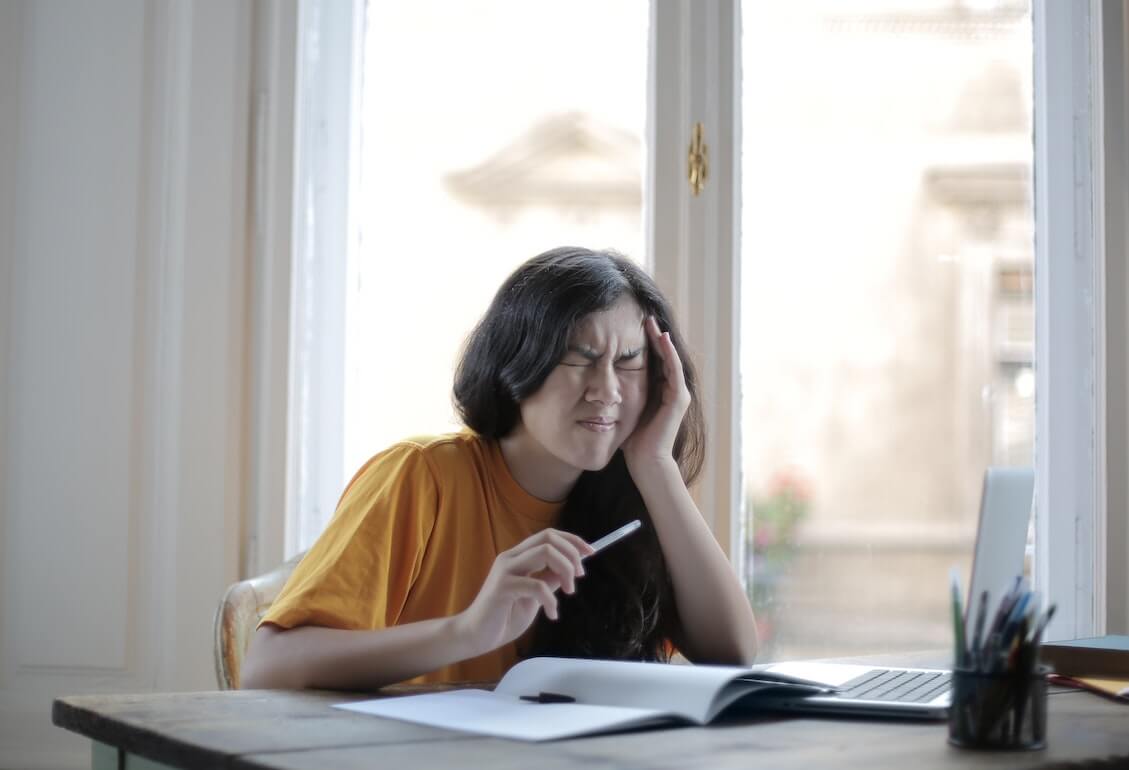Case of 37yo woman with Migraine and Celiac Disease
Overview
Migraine headaches are a common and debilitating condition that is highly manageable. However, most management is focused on pharmacological agents that carry undesirable side effects such as potential for addiction, toxicity, and overuse headaches; and can themselves create a debilitated state for individuals. Also for many, standard treatments may be cost prohibitive, and tedious to find the right medication and dosage. Acupuncture is a potentially effective alternative that is affordable and carries low risk for side effects.
A 38 year old female with Celiac Disease presented with recurring episodic migraines. She was successfully treated with acupuncture points protocol of direct abdominal points with Miriam Lee protocol. After frequent treatments for two months, she did not have a recurrence of migraine, and she continued to avoid recurrence with regular monthly maintenance. Digestive diseases such as Celiac Disease that can cause inflammation of the nervous system may contribute or correlate with occurrence of migraines, acupuncture and Chinese medicine is a safe and effective tool for both acute and prophylactic migraine management without the risk of side effects such as overuse headaches. More exploration is needed on this population of migraine sufferers.

Public Health Considerations
Allopathic treatments for migraine can be divided into
1) Lifestyle modification and trigger avoidance
2) Acute or abortive treatments
3) Prophylactic/preventative treatments
Currently accepted migraine management tools are pharmacologic, although there is increasing interest in nerve blocking therapies, surgical interventions, and botulinum injections when pharmacologic treatments are unsuccessful. There is also increasing interest in alternative therapies such as biofeedback therapy, acupuncture, transcutaneous electrical nerve stimulation (TENS), cognitive behavior therapy (CBT), and relaxation training. One important concern with pharmacologic treatments is the potential for overuse headaches caused by overuse of medications. Pregnancy is another consideration as most pregnant women prefer to use non-pharmacologic interventions whenever possible. Finally, avoidance of opiates is now also another consideration.
A huge public health concern in regards to migraines is the burden of cost that is put onto the economy. Migraines are most prevalent in individuals from 25-55 years of age, peaking around 40 years of age. These are the most productive years for a person’s lifetime, and the lost of productivity is costing the economy billions, with roughly $8-13 billion being attributed to migraines specifically. These are considered indirect costs and they may be an underestimate since migraines are often under reported or under diagnosed, or misdiagnosed. The direct costs to individuals suffering from migraines and their families is also substantial. Since we now understand migraines to be a progressive disease, the costs to individuals will span over the lifetime. Individuals are now compounding personal costs of pain management with income loss if treatments are ineffective or if the side effects of treatments are also debilitating. Unfortunately, individuals suffering from migraines are feeling the economic burden on two fronts.
Case Description
A 37 year old female had been suffering from migraines for several years. Her migraines were preceded by visual scotomas (a blind spot or loss of vision where there is usually normal visual field) and extreme fatigue, including much yawning. The pain begins behind her right eye before radiating out to the rest of the head. The visual auras and fatigue would occur for two days, followed by two days of actual migraine pain, and then two to three days of recovery before she felt normal again. During this time, she reported her pain as being debilitating and she could not leave the house. Usually, the migraines were triggered by the onset of her monthly menstruation, but lately, her migraines have been coming on without any noticeable triggers, so she was getting migraines twice monthly that would take five days each time to fully get through and recover from. The patient rated the pain at 8-9 out of 10 pain. She reported that she had prescriptions for migraine pain medications in the past but that they did not help. She took ibuprofen to take some of the edge off for the two days of active pain. She did not like to take more than 800mg of ibuprofen, so she would take 400mg twice daily for the two days. The ibuprofen only helped take her pain down to about 6-7 out of 10 pain. She said the reduction in pain was not enough for her to be functional, but it was enough for her to rest and sleep. She reported also having slight nausea, but no vomiting, and no other significant recurring symptoms. She denied any history of head trauma.
In the past, the patient had tried acupuncture and it was helpful. It reduced her auras and her recovery time so that she was only home-bound for three days at a time. This allowed her to still work and have a life. Since her insurance stopped covering acupuncture, she was not able to get the regular treatments that she needed, and now her migraines are becoming a life-inhibiting factor, making it difficult for her to work and take care of her family. When the patient first presented, she had just gotten through two days of active migraine and was on the first day of recovery. She still had an active headache at the left eye and was fatigued and had difficulty concentrating on and answering the questions being asked. The intake was kept to a minimum and more information was gathered in subsequent visits.
She also had active Celiac Disease, but was not compliant with avoiding gluten. Her bowels movements were inconsistent and she was prone to constipation alternating with soft or loose stools. Sleep was erratic, and impossible with active migraine. Stress often triggered poor sleep.
Treatment Implemented
The patient began with twice a week treatments until her migraine frequency decreased to a few days a month. She continued with weekly treatments until the migraines ceased completely. Once migraines cease, she was advised to continue at least once or twice monthly treatments the week leading up to her menstruation.
Treatment Principle
The treatment principle was to strengthen her digestive system in order to reduce the systemic inflammation that it caused. In TCM language, I warmed Spleen qi so that her body could properly manifest Gu Qi. This translates to the idea that by promoting adequate digestion, and encourage the transforming and transporting functions of the Spleen qi, we decrease inflammation and improve digestion to increase the nutrient absorption.


The points chosen were on the Stomach and Large Intestine channels:
Zusanli ST-36, Hegu LI-4, Quchi LI-11, Lieque LU-7, and Sanyinjiao SP-6. Tianshu ST-25, Qihai CV-6, and Zhongwan CV-12. Finally, the extra point Yintang was also added as a strategic local point to work on the head and to sedate the patient.
Adjunctive treatments included diet and lifestyle recommendations including: decreasing sugar, being more diligent with gluten avoidance, eliminating dairy, being more diligent with water intake of at least 50 ounces in a day, not including coffee or tea, avoiding raw or cold foods for the meantime, and once the anemia was confirmed, going on iron supplementation.
The patient was encouraged to exercise regularly to improve Qi and Blood circulation and decrease stress.
Treatment Outcome
- After the first treatment, the patient’s post-migraine symptoms, energy, and demeanor improved. She was able to concentrate on questions and gave more thorough answers during the second visit.
- After twice weekly treatments four weeks, the patient only experienced one headache during her next menses. The patient reported having her menses and no migraines occurred, she had a mild headache that subsided after a few hours. She did not need to take ibuprofen.
- We decreased the treatment frequency down to once weekly treatments and she had no headaches at all during her following month’s cycle.
The patient remained a patient for two years. There were occasions when her life stressors increased and she would feel the premonitions of a migraine, but if she came in for treatment, she was usually able to avoid a full migraine episode. As long as the patient was compliant with monthly maintenance treatments, her prognosis is good. She will likely not experience migraines unless her body experiences a sudden change in environment or circumstance. With long-term management of diet and lifestyle, she may even be able to reduce her acupuncture maintenance down to every two or three months.
Long-term Prognosis
This patient will always need intervention and maintenance for her episodic migraine pain because this is a condition that is recurrent and chronic and compounded by a complex network of nervous system overstimulation and chronic inflammation. Acupuncture is effective is both an acute/abortive treatment and a prophylactic/preventative treatment for migraine pain. Finally, although acupuncture is helpful in maintenance and remission, the Lifestyle and Dietary choices that one makes will have the biggest daily influences and long-term influence as well. A regular visit to the acupuncturist can help guide and motivate patients to improve their lifestyle and dietary regimen and trigger avoidance.
References for this article
Lipton R, Bigal M, Diamond M, Freitag F, Reed M, Stewart W. Migraine prevalence, disease burden, and the need for preventive therapy. Neurology. 2007;68(5):343-349. doi:10.1212/01.wnl.0000252808.97649.21
Gabrielli M. Association between migraine and celiac disease: results from a preliminary case-control and therapeutic study. Am J Gastroenterol. 2003;98(3):625-629. doi:10.1016/s0002-9270(02)06022-7
Hazard, Elisabeth et al. “The Burden of Migraine In The United States: Current And Emerging Perspectives On Disease Management And Economic Analysis.” Value In Health, vol 12, no.1, 2009, pp.55-64. Elsevier BV, doi:10.1111/j.1524-4733.2008.00404.x. Accessed 11June2019.
Allais G, De Lorenzo C, Quirico P et al. Acupuncture in the Prophylactic Treatment of Migraine Without Aura: A Comparison with Flunarizine. Headache: The Journal of Head and Face Pain. 2002;42(9):855-861. doi:10.1046/j.1526-4610.2002.02203.x
Yang Y, Que Q, Ye X, Zheng G. Verum versus Sham Manual Acupuncture for Migraine: A Systematic Review of Randomised Controlled Trials. Acupuncture in Medicine. 2016;34(2):76-83. doi:10.1136/acupmed-2015-010903
Chen J, Zhao L, Zheng H et al. Evaluating the prophylaxis and long-term effectiveness of acupuncture for migraine without aura: study protocol for a randomized controlled trial. Trials. 2013;14(1):361. doi:10.1186/1745-6215-14-361
Bäcker M, Grossman P, Schneider J et al. Acupuncture in Migraine: Investigation of Autonomic Effects. Clin J Pain. 2008;24(2):106-115. doi:10.1097/ajp.0b013e318159f95e

